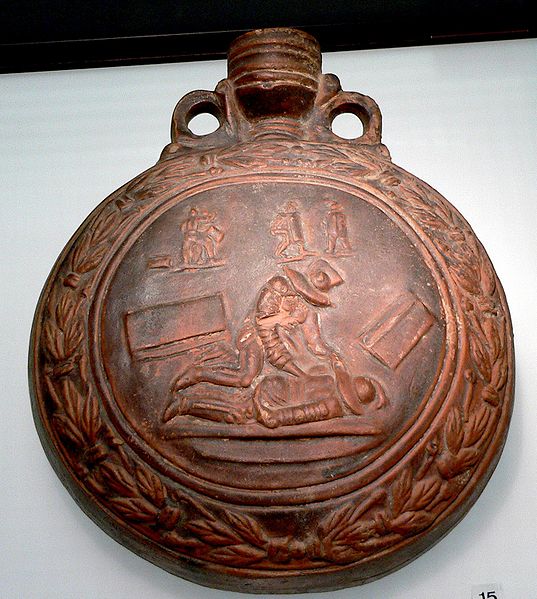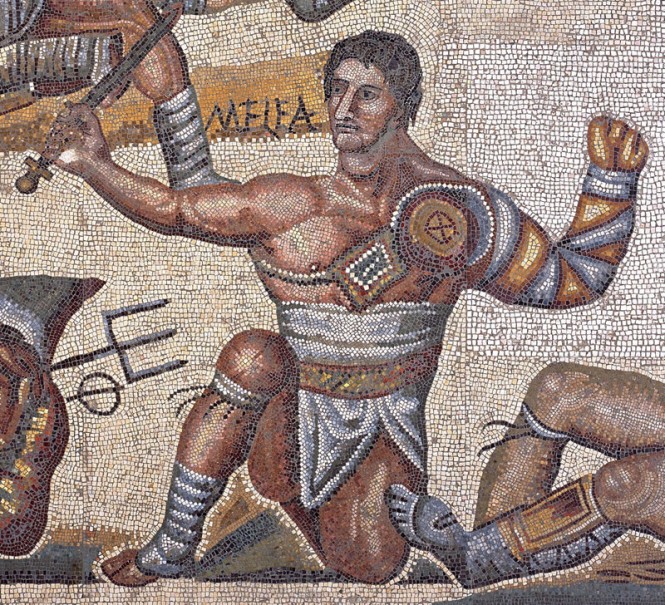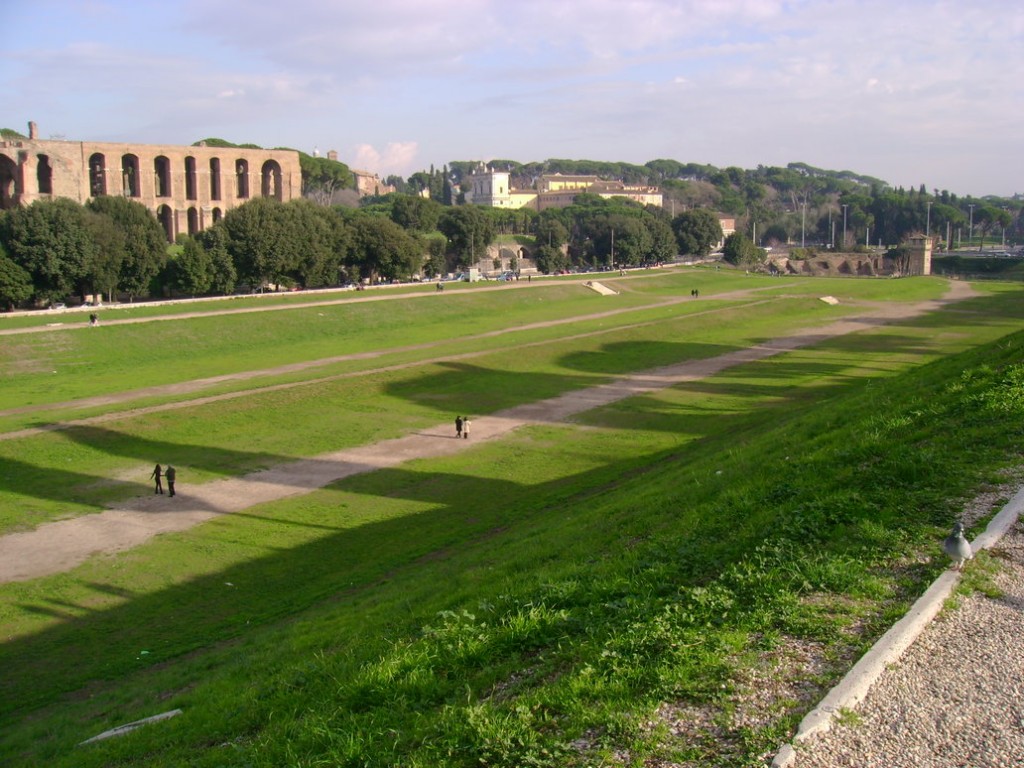CLAS 355
Spectacles of Violence (Gladiators & Chariot Racing)
March 2, 2023

Gérôme, pollice verso, 1871 (cf. Juvenal, Satire 3.36, "when the crowd gives the order with (up?)turned thumb, they just kill as the people want")
*Examination #2: Thursday, March 16
CLAS 355 Part IV: Spectacles of Violence in Amphitheaters & Theaters (+ Circuses): paradox of preserving "civilization" through institutionalized violence (gladiators & chariot races today; 3/14 hunts & executions; Seneca's tragedy)

Gladiators on 4th century CE mosaic, Rome (abbreviation θ = Greek θάνατος, “death”)
Gladiator Contests: harena, "sand" > arena = amphitheater
("blood in the sand")
- origins (264 BCE): funeral of Junius Brutus Pera in cattle-market of Rome; munus/munera ("gifts/obligatory offerings") to deceased aristocrat in temporary public venue ("funeral games")
- attached to ludi ("festivals"): thanksgiving to gods & securing gods' goodwill + political occasions; competitive displays of Republican magistrate's generosity; emperor's responsibility in imperial Rome (Augustus), e.g. appearances in imperial box, special prizes, responsive to spectators (measure of popularity)
- imperial combats institutionalized spectator sport; spectacles a marker of Roman cultural identity; pervasive feature of Roman social life
Petronius, Satyricon 45, mid-first century CE (dinner conversation: audience demands!)
"We'll have the best sword-fighting, no running away, a regular butcher-shop right there in the amphitheater . . . he [Titus, the sponsor] has already got some freaks, a woman essedarius, and Glyco's steward that got caught showing his mistress a good time. You'll see the audience brawling, the jealous husbands against the tomcats . . . Look, we're gonna have an excellent munus on the third day of the festival, not just some lanista's familia but a bunch of freedmen."
- amphitheater a uniquely Roman structure & symbol of power: first stone amphitheater at Rome by Statilius Taurus in 29 BCE; Vespasian (emperor 69-79 CE) begins work on Colosseum/Flavian Amphitheater over site of Nero's "Golden House", completed by son Titus (emperor 79-81 CE); spectacles of afternoon gladiator contests + morning hunts and noontime executions


- dishonored status of gladiators: POWs, convicted criminals, slaves accused of crimes or sold by masters; free persons subject to infamia (free & even aristocratic gladiators, e.g. Commodus, emperor 180-92 CE))

Emperor Commodus, ca. 192 CE
- gladiators owned by lanista ("trainer/manager" of gladiator familia)
- training of gladiator familia under lanista in quasi-prison: specialized weapons instructors, doctors, diets (grains); oath lanista "to be burned by fire, bound in chains, to be beaten and die by the sword" on admission to gladiator school

Gladiator Barracks at Pompeii
ILS 5145 (advertisment, Pompeii)
Decimus Lucretius Satirus Valentis, permanent flamen of Nero Caesar son of Augustus, will have 20 pairs of gladiators fight, and his son Decimus Lucretius Valentis will exhibit 20 pairs, at Pompeii 8-12 September. There will be a lawful venatio and awnings. Aemelius Celer wrote this.
- gladiators named for gladius, sword of Roman soldier: well-trained, highly skilled experts in weapons, courage & discipline before death > model of Roman militaristic values


L: Alumnus the retiarius vs. Mazicinus the secutor; R: Gladiator & Referee, Kourion, Cyprus
- types of gladiators (increasing number of types/novelty, e.g. women gladiators): balance of defensive & offensive equipment in duels, torso exposed
(1) retiarius ("net-man"): trident, metal net, dagger, bare head, no shield, no greaves; flight a technique vs. (2) secutor ("pursuer"): long rectangular shield, visored helmet, greave(s), protected sword arm (manica: leather sleeve with metal reinforcement), short stabbing sword
(3) essedarius ("chariot fighter"): fought from chariot (?) to choreography of hydraulic organ (?)
(4) Thraex ("Thracian"): wide-brimmed, visored & plumed helmet, small shield, bent sword vs. (5) murmillo ("fish-man"): helmet like Thracian's with fish emblem, large shield, short sword
animated (commercial) documentary on gladiator types: https://www.youtube.com/watch?v=ddxGS378Yds


L: Thraex vs murmillo, mosaic from Germany, 3rd century CE: R: Bronze flask depicting murmillo defeating Thraex, 2nd century CE

Gladiator Mosaic from Zliten, Libya (L: Thraex vs. murmillo; R: murmillo surrendering), 2nd century CE
dir. Stanley Kubrick, Spartacus (1960): gladiatorial fight at Capua: https://www.youtube.com/watch?v=251eT20NtOI
- nature of combat: trained in art of killing & dying (oath); formality & rules, 2 umpires; gladiators usually fight only once per show, 2-3 times per year
- highly theatrical spectacle: costumes, masks, props, music (pipes, horns, organs), gladiator stage-names (e.g. Pertinax, "Tenacious"; Ferox, "Fierce"; Hilarus, "Joker"), stadium-atmosphere, real, not simulated violence

- potential fight to death (raised finger in defeat), but pair of fighters or winner can be dismissed (missio = "release"); combat "without release" unpopular & forbidden by Augustus, appeal for release by popular acclaim (audience input, e.g. iugula!, "cut his throat", thumbs up (?) toward throat for death) + financial incentives of owners, sponsors
ILS 5062 (Minturno, 249 CE)
To Publius Baebius Terentius Justus . . . At Minturno over 4 days he put on 11 pairs, of whom he killed 11 first-rate gladiators from Campania, and also cruelly killed 10 bears.

- crowd favorites: prizes (money + palm frond), celebrity & possibility of freedom/manumission; hyper-masculinized outsiders and anti-heroes (e.g. Spartacus); free women & gladiators?
Juvenal, Satire 6.98ff., early 2nd century CE (Eppia the aristocratic "Gladiator-Girl" violating social taboos)
If her [Eppia's] husband orders her, it's hard to travel on board ship: the bilge-water smells and she's dizzy with seasickness. But if she's following her lover, her stomach's fine. The one vomits all over her husband, the other eats with the sailors, runs up and down the deck, and loves to pull on the rough ropes. So what kind of body does Eppia burn for? Whose youth has caught her eye? What does she see for which she puts up with being called "Gladiator Girl"? Her dear Sergius has already begun to shave his throat, like an older fellow, and to anticipate retirement with his cut-up arm. There are lots of ugly things on his face, like a huge wart on the middle of his nose, right where the helmet rubs it, and foul stuff always dripping from his eyes. But he was a gladiator. That makes him a Hyacinth; for that, she prefers him to her sons, her country, her sister, and her husband. It's the sword they love.

- private lives of gladiators: families, manumission & retirement, camaraderie, burial collegia & funeral inscriptions; varying duration of careers
ILS 5087 (Nemausis)
Lucius Sestius Latinus the trainer dedicated this to Quintus Vettius Gracilis, a Thraex who won three crowns, aged 25, from Spain.
ILS 5089 (Rome)
Sacred to the memory of Macedonus, novice Thraex, Alexandrian, well-deserving , erected by all Thraeces together. He lived 22 years 8 months 12 days.
ILS 5113 (Sicily)
Flamma, secutor, lived 30 years, fought 34 times, conquered 21, received missio standing 9 times, received missio 4 times, Syrian by birth. Delicatus erected this for his deserving fellow-fighter.
ILS 5123 (Tergeste)
Constantius who gave this munus has given this tomb to his gladiators because the munus was well received. To Decoratus the retiarius, who killed Caeruleus and died himself; as both died by the same sword, so the pyre covers both. Decoratus the secutor, after 9 fights, left his wife Valeria grieving for the first time.

30,000 seat Amphitheater of Verona (today), completed in 30 CE
- ambivalent elite attitudes (generally anti-spectacles): admiration for gladiator's virtus ("manliness") > courage, endurance, loyalty, sense of duty; model for heroic triumph over death, e.g. Cicero, Tusculan Disputations 2.41, "What blows gladiators, who are either desperadoes or barbarians, endure! . . . Shall then a 'filthy Samnite, worthy of that life and place' be able to do this, while a man born for glory shall have a single spot of his mind so weak that he cannot harden it by practice and theory?"
St. Augustine (354-430 CE), Confessions 6.98 (psychological portrait of Alypius, forced by his friends to watch ludi at the amphitheater)
When they got in and found seats, the whole place was hot with monstrous passion. Alypius closed his eyes, shut the door to his mind, and forbade himself to get involved with such evils. But it would have been better if he could have closed his ears as well. For at one moment, when something happened in the fight and he was struck by a huge shout from the whole audience almost like a physical blow, his curiosity got the better of him. He had almost prepared himself to see what it was, and whatever it was to disdain and conquer it, but when he opened his eyes he was wounded as gravely in his soul as the other man was in his body—the gladiator he had lusted to see. And Alypius was more wretchedly defeated than the man whose death had given rise to the shouting. When he saw the blood he drank in the monstrosity and did not turn away, but kept his eyes glued to the sight and was steeped in madness, unaware of what was happening. He was fulfilled by the evil of the contest and drunk on the cruel pleasure. And he was no longer the same person who had come, but just one of the crowd he had come to, a true member of the gang who had brought him there.
Scenes from Ridley Scott's Gladiator (2000):
chaotic combat scene: https://www.youtube.com/watch?v=lTmlYKiLBHI
"My name is Maximus": https://www.youtube.com/watch?v=lKn-Agk-yAI
opening: https://www.youtube.com/watch?v=-MYxtpGxGJI
Roman Chariot Racing: Rome's most popular entertainment ("hippomaniacs"), 24 races/day during festivals (66 days annually in 4th century CE)

Circus Maximus today
- enduring popularity: races in Rome mid-late 6th century CE; meeting place of all Roman society (shops, restaurants, brothels, etc.)
Ovid, Amores 3.2, late 1st century BCE (taking advantage of seating arrangements to hook up)
I'm
not sitting here out of any love for famous horses, but I do pray that the one you're rooting for wins. I've come here so I can talk to you and sit with you, and so that you may not be unaware of the love you've inspired in me. You're watching the races, I'm watching you: let's each feast our eyes on what pleases us most . . .
- ludi circenses: festivals with chariot racing; opening pompa = religious procession before races with gods' statues (but highly secularized entertainment)
Ovid, Amores 3.2
Now the procession comes . . . Victory with her wings spread out: goddess, grant that my love be victorious. Applaud Neptune, you who trust so much to the waves; I want nothing to do with the sea—I'll stick to the land. Soldier, applaud your Mars; I hate war; peace is pleasanter, and in peace we discover love. May Phoebus stand by the prophets and Phoebe by her hunters, and craftsmen turn their hands to you, Minerva . . . I applaud you, gentle Venus, and your boys with powerful bows. Goddess, look with favor on my undertaking and give sense to my new mistress, that she may permit herself to be loved. The goddess nods and gives a sign of approval. Now I ask you that you promise me what the goddess has promised: you will be more of a goddess to me than Venus herself. I swear by you and all the gods in the procession that you will be my mistress for all time.

- factions/stables: Whites, Reds, Blues, Greens + Domitian's (emperor 81-96 CE) Golds & Purples; stables privately owned, become responsibility of emperor in 3rd century CE; fan attachment to colors
Pliny the Younger, Letter 9.6, late 1st century CE
The circus was going on, a type of spectacle I'm hardly interested in at all. Nothing new, nothing unusual, nothing one needs to see more than once. I'm always amazed that so many thousands of men so childishly love to watch the horses run and the men standing in the chariots. If they were attracted to the speed of the horses or the technique of the charioteers, there'd be some reason for it, but they cheer for a bit of cloth, they love their flag. If right in the middle of the race two drivers switched colors, the favor of the crowd would switch too. Suddenly they'd be screaming out the names of those drivers and those horses that they ignored before. So much charm and so much authority in a filthy tunic: I can understand this from the ordinary folks, whose own tunics are filthier, but even serious men feel this way.
- status of charioteers: slaves or lowest ranks of society seeking chance for celebrity (cf. mother's tomb inscription for son, "To Coecilius Pudens, partisan of the Blues")
- Roman hippomaniac charioteering statistics!
ILS 5287 (Rome, 146 CE), Diocles
Gaius Appuleius Diocles, driver for the Red faction, Lusitanian by birth, aged 42 years 7 months 23 days . . . Total: drove a quadriga for 24 years, sent from the gate 4,257 times, won 1,462, from the pompa 110 . . . He took second place 861 times, third 576, fourth with a 1,000-sesterces prize once, and finished out of the money 1,351 times . . . His total winnings were 35,863,120 sesterces. . . . He won leading from the start 815 times, coming from behind 67, after being passed 36, in various ways 42, and at the finishing line 502. He won against Greens 216 times, against Blues 205, and against Whites 81. Nine horses had 100 victories with him and one had 200.
- circus ("circle"): 4 major tracks in Rome; Circus Maximus dates from 6th century BCE (valley between Aventine & Palatine hills)

(1) 680 x 150 yards (12x Colosseum)
(2)
estimated seating capacity 150-250,000 (seating by social status; women & men mix)
(3)
floor of arena compacted earth with layer of sand
(4)
spina: continuous barrier (365 yards) down middle; 7 eggs & 7 dolphins + shrines, altars, statues
(5)
metae: rounded turning posts at each end
(6)
carceres: starting gates (12), drawing of lots for start
(7)
white cloth (mappa) dropped by magistrate; starting mechanism, various officials, break line, counterclockwise laps (ca. 1,500m), brutal strategies & little protection for drivers
Virtual reconstruction of Circus Maximus: https://www.youtube.com/watch?v=9YnQmY8qWXs


Chariot racing mosaic in racetrack, Cyprus, 4th century CE
- usually 4 horse & 2 horse chariots; driver stands upright (leather helmet, whip, colored tunic, reins + dagger)
- positioning at metae critical: crashes ("shipwrecked"), cure of wild boar's dung smoothie
Chariot-racing scene in William Wyler's Ben-Hur (1959), starring Charlton Heston: https://www.youtube.com/watch?v=frE9rXnaHpE

- victory: palm or crown + prize money (fan betting)
- large-scale team sport: mob psychology (factions), some peripheral violence, disorder, demonstrations, e.g. Nika riots in Byzantium/Constantinople (ca. 30,000 die in 532 CE)
Josephus, Jewish Antiquities 19.24.7, late 1st century CE (Caligula's poor patronage)
At this time there occurred chariot races. This is a kind of sport to which the Romans are fanatically devoted. They gather enthusiastically in the circus and there the assembled throngs make requests of the emperors according to their own pleasure. Emperors who rule that such petitions are to be granted are highly popular. So in this case they desperately entreated Caligula to cut duty taxes and grant some relief from the burden of taxes. But Caligula had no patience with them, and when they shouted louder, he dispatched agents among them in all directions with orders to arrest any who shouted, to bring them forward at once and to put them to death. The order was given and those whose duty it was carried it out. The number of those executed in such summary fashion was very large. The people, when they saw what happened, stopped their shouting and controlled themselves, for they could see with their own eyes that the request for fiscal concessions resulted quickly in their own deaths.




















